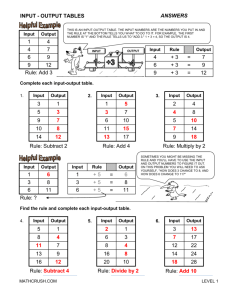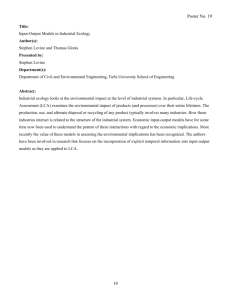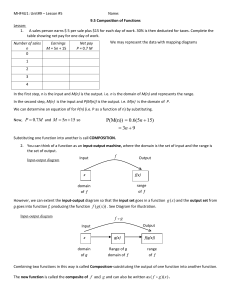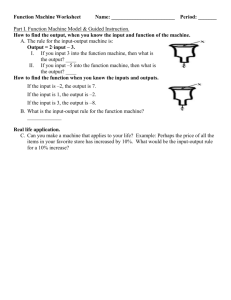Background Notes and Methodology - Supply and Use and Input-Output...
advertisement
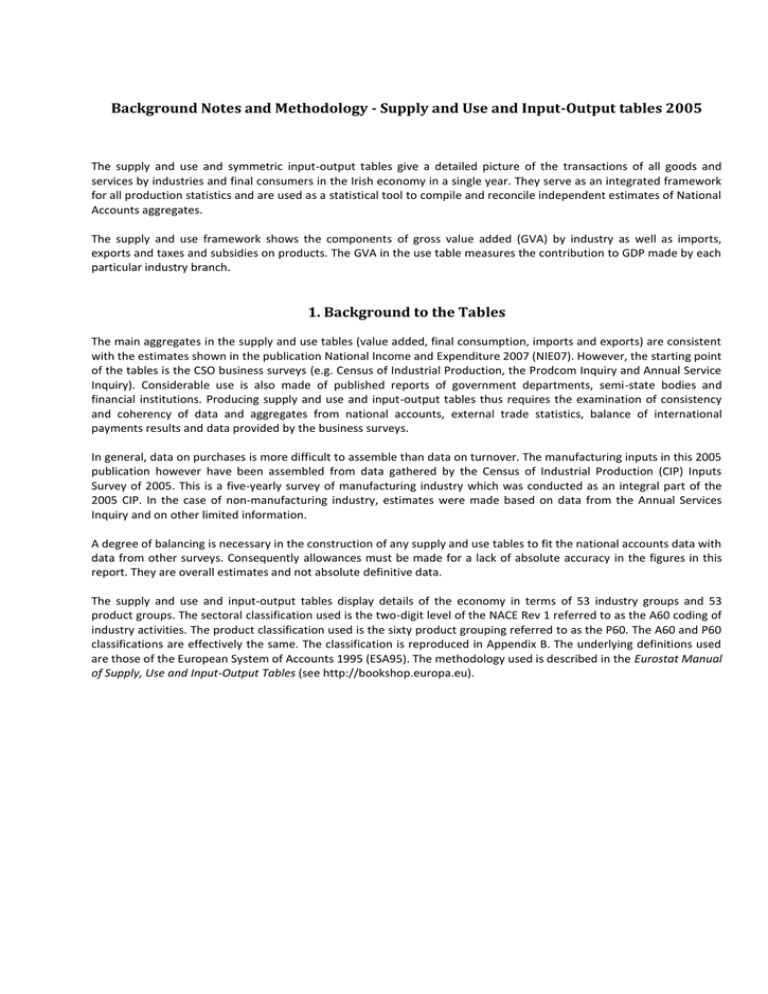
Background Notes and Methodology - Supply and Use and Input-Output tables 2005 The supply and use and symmetric input-output tables give a detailed picture of the transactions of all goods and services by industries and final consumers in the Irish economy in a single year. They serve as an integrated framework for all production statistics and are used as a statistical tool to compile and reconcile independent estimates of National Accounts aggregates. The supply and use framework shows the components of gross value added (GVA) by industry as well as imports, exports and taxes and subsidies on products. The GVA in the use table measures the contribution to GDP made by each particular industry branch. 1. Background to the Tables The main aggregates in the supply and use tables (value added, final consumption, imports and exports) are consistent with the estimates shown in the publication National Income and Expenditure 2007 (NIE07). However, the starting point of the tables is the CSO business surveys (e.g. Census of Industrial Production, the Prodcom Inquiry and Annual Service Inquiry). Considerable use is also made of published reports of government departments, semi-state bodies and financial institutions. Producing supply and use and input-output tables thus requires the examination of consistency and coherency of data and aggregates from national accounts, external trade statistics, balance of international payments results and data provided by the business surveys. In general, data on purchases is more difficult to assemble than data on turnover. The manufacturing inputs in this 2005 publication however have been assembled from data gathered by the Census of Industrial Production (CIP) Inputs Survey of 2005. This is a five-yearly survey of manufacturing industry which was conducted as an integral part of the 2005 CIP. In the case of non-manufacturing industry, estimates were made based on data from the Annual Services Inquiry and on other limited information. A degree of balancing is necessary in the construction of any supply and use tables to fit the national accounts data with data from other surveys. Consequently allowances must be made for a lack of absolute accuracy in the figures in this report. They are overall estimates and not absolute definitive data. The supply and use and input-output tables display details of the economy in terms of 53 industry groups and 53 product groups. The sectoral classification used is the two-digit level of the NACE Rev 1 referred to as the A60 coding of industry activities. The product classification used is the sixty product grouping referred to as the P60. The A60 and P60 classifications are effectively the same. The classification is reproduced in Appendix B. The underlying definitions used are those of the European System of Accounts 1995 (ESA95). The methodology used is described in the Eurostat Manual of Supply, Use and Input-Output Tables (see http://bookshop.europa.eu). 2. Overview of the Tables There are five transactions tables in the publication: Table 1 Supply Table at basic prices (product by industry) Table 2 Use Table at purchasers’ prices (product by industry) Table 3 Use Table for imports at basic (c.i.f.) prices (product by industry) Table 4 Symmetric Input-Output Table of domestic product flows (product by product) Table 5 The Leontief inverse of domestic flows with multipliers for other inputs (product by product) Table 1 - Supply Table This table provides estimates of the supply of goods and services (products) by domestic industries as well as imports of goods and services. The supply of products is presented in the rows while the columns show the industry branches that produce these goods and services. Each industry is classified according to whichever product accounts for the largest part of its output. Its principal production, shown on the diagonal elements of the supply table, is therefore larger than its secondary production shown on the off-diagonal elements. A summary of the 2005 supply table is shown below. 2005 Supply Table at basic prices €m industries Ag, for, Manufacturing Construction Distribution, Business fish comm products (1-5) (10-41) (45) Ag, for, fish 7,200 - - Manufacturing - Construction - 106,752 2 38,440 31 3,235 - Business services 62 2,518 322 Output 70 2 7,364 112,509 - - Distribution, comm. Other services (50-64) 87 - 74 Total Domestic Imports c.i.f. Margins Taxes less subsidies Total supply (purchasers' prices) (75-95) 32 7,200 1,061 655 -1,085 7,832 106,945 56,072 18,761 11,032 192,810 3,632 42,083 - - 38,442 48,751 562 - 52,579 12,268 -19,416 1,923 47,354 736 81,367 295 85,301 43,038 - 3,287 131,626 38,762 (65-74) Other services 92 49,666 82,003 9 - 40,730 40,893 369 - 188 41,451 41,057 331,360 112,819 - 18,977 463,156 Treatment of the motor trade, retail and wholesale The outputs of the distribution sector are defined in a special way for national accounts purposes and may not be as expected. The motor trade, retail and wholesale activities are regarded as producing a service which is measured as the price at which their products are sold minus the purchase price of these products (which they purchased for direct resale). This is referred to as the gross margin. Thus the retail supermarket is not regarded as providing food or drink nor is the drapery outlet regarded as providing clothes. In the supply and use framework, the food and clothes are the products of their respective industries or are imported and retailers are regarded as providing a sales service (see the distribution rows 50 – 52 of the supply table). The gross margin is also used to measure the output of distribution activity by firms that are mainly involved in another activity such as manufacturing. Valuation The values of the domestically produced products in the supply table are shown initially at basic prices while they are transformed to purchasers’ prices in the final columns. Imports are shown at c.i.f. (carriage, insurance and freight inclusive) prices as in the published merchandise trade statistics. The basic price is the price receivable by the producer for a unit of a good or service produced, minus any tax payable as a consequence of its production or sale (i.e. taxes on products), plus any subsidy receivable on that unit as a consequence of its production or sale (i.e. subsidies on products). Thus the basic price excludes the well-known product taxes such as vat, excise duties, import duties etc. In theory, the basic price excludes any transport charges invoiced separately by the producer but includes any transport charges charged on the same invoice. It does not include any trade margin. The basic price measures the amount retained by the producer and is therefore the price most relevant for the producer’s decision making. The purchaser’s price is the price the purchaser actually pays for the product including any taxes less subsidies on the product (but excluding deductible taxes). The conversion from basic prices to purchasers’ prices involves distributing the trade margins of retailers and wholesalers among the products on which they are charged. The margin in the motor trade and domestic wholesale and retail trades appears as negative values in rows 50 to 52 of the trade margin column of the supply table as these margins are distributed in the same column among the products on which they fall. Table 2 - Use Table at purchasers’ prices This table shows the use of products by domestic industry and by the final demand sectors, i.e. consumption by households, government, non-profit organisations serving households (NPISH), capital formation (GFCF) and export. As in the previous table, industries are shown in the columns and products in the rows. Thus the columns of figures for industries 1 - 95 show the goods and services used by each industry for the purposes of achieving its output. The purchases in these columns relate to intermediate consumption only. The capital purchases are shown separately but a breakdown by industry is not provided. All the purchases of households in their private (non-business) capacity as consumers are included under household consumption with the exception of the purchase of dwellings, which is included with capital formation. Additional information for each industry is shown at the end of the industry columns, where estimates of the components of the gross value added by each industry are supplied. These are in the form of compensation of employees (COE), non-product (i.e. overhead) taxes and subsidies, net operating surplus (or profits) and consumption of capital (or depreciation). The latter two items, when combined, are referred to as gross operating surplus (GOS). The sum of these rows is referred to as the gross value added of the industry and is equal to the output of the industry minus its intermediate consumption costs. 2005 Use Table in purchasers' prices €m industries Ag, for, Manufacturing Construction Distribution, Business Other fish comm. services products Ag, for, fish (1-5) 1,479 (10-41) 3,934 Manufacturing 2,394 Construction (45) Total inter- Consumption industry and GFCF Exports Total uses 74 (50-64) 251 (65-74) 6 (75-95) 67 5,810 1,343 678 7,832 32,732 10,492 7,965 2,429 4,713 60,724 40,594 91,492 192,810 42,083 79 193 10,078 165 646 650 11,811 30,272 - Distribution, comm. 131 8,311 358 7,917 4,201 1,398 22,316 15,403 9,634 47,354 Business services 376 31,653 3,096 6,311 34,376 4,484 80,296 21,244 30,086 131,626 Other services 174 490 467 688 728 4,665 7,212 33,762 477 41,451 4,632 77,312 24,565 23,296 42,387 15,977 188,169 142,619 132,368 463,156 COE 531 10,975 9,384 13,216 10,969 20,889 65,963 GOS 3,489 23,769 4,788 12,461 28,569 4,044 77,120 Taxes less subsidies -1,288 452 25 694 78 147 108 value added 2,732 7,364 35,197 112,509 14,196 38,762 26,371 49,666 39,616 82,003 25,080 41,057 143,191 331,360 Total Output Valuation The purchases of the products in the use table are valued at purchasers’ prices, which have already been explained in the note on the supply table above. There is no distinction in this table between imported and home produced products. The gross value added of the industries shown in the second last row, being equal to the output of the industries valued at basic prices minus their intermediate consumption at purchasers’ prices is regarded as being valued at basic prices. Balancing the Supply Table with the Use Table The total supply of each product in the last column of the supply table is equal to the total use of the product in the last column of the use table. Similarly, the total output of each industry in the last row of the supply table is equal to the sum of the intermediate consumption and value added of that industry, which is the last row of the use table. Table 3 – Use Table for imports at basic prices This table is similar to the main part of Table 2 above but is confined to imports. It shows the use by the industries of imported goods and services for their day to day activities. It also shows the use by the elements of final demand sectors (e.g. household consumption, capital investment etc.) of imported goods and services. There is a greater degree of estimation in this table than in the others as there is a lack of survey data on the use of imports. In many cases the use of imports of a particular commodity by an industry group or final demand sector had to be estimated based on the percentage which the total imports of the product in question formed of the total supply of the product in the State. Table 4 - Symmetric Input-Output Table for domestic output at basic prices This table is derived from the preceding three tables. The transformation of the supply and use tables to input-output table is based on the commodity technology assumption.1 The input-output table forms the basis of Table 5 which contains the Leontief inverse coefficients which are required by users of input-output techniques to assess the implications of changes in demand on the various sectors of the economy. It purports to show the use made of domestically produced products in the manufacture or provision of other products. A summary of the input-output table is shown below. 2005 Symmetric Input-Output Table of domestic product flows €m products Ag, for, Manufacturing Construction Distribution, Business fish comm products Ag, for, fish Manufacturing Construction (1-5) 1,424 (10-41) 4,117 820 (45) Other services Interindustry Consumption and GFCF Exports Total outputs 63 (50-64) 249 (65-74) 9 (75-95) 64 5,925 597 678 7,200 7,411 4,078 2,463 910 1,184 16,866 5,122 84,957 106,945 77 184 10,062 166 579 612 11,679 26,762 - 38,442 Distribution, communication 498 4,186 1,516 6,848 3,229 1,740 18,017 23,253 11,309 52,579 Business services 348 5,118 2,977 5,114 17,214 4,002 34,774 20,441 30,086 85,301 Other services 169 443 462 683 782 4,490 7,028 33,388 477 40,893 Intermediate consumption 3,337 21,459 19,158 15,522 22,722 12,091 94,290 109,562 127,508 331,360 Imports 1,316 53,247 4,978 6,923 20,184 2,781 89,428 18,532 4,860 112,819 -94 651 305 1,091 1,530 969 4,451 14,526 - 4,559 462 75,357 9,589 24,440 9,380 23,536 14,196 44,436 11,458 15,841 20,878 188,169 65,963 142,619 77,120 Product taxes less subsidies Total at purchasers' prices COE GOS 3,466 21,598 4,597 14,089 29,342 4,027 -1,287 402 24 757 65 147 108 Value added 2,641 31,589 14,001 29,043 40,865 25,052 143,191 Total inputs (= total outputs) 7,200 106,945 38,442 52,579 85,301 40,893 331,360 Other taxes less subsidies 1 132,368 18,977 463,156 See Handbook of Input-Output Table Compilation and Analysis, United Nations Publication, Sales No. E99XVII.9, New York, 1999 The structure of the input-output table (I-O table) is similar to the structure of the use table but differs in the following ways: The I-O table is product-by-product and thus shows the use of products in the production of other products. Purchases are valued at basic prices. (The basic price is the price received by the producer for a good or service produced minus any tax payable as a consequence of its production plus any subsidy received as a consequence of its production. It excludes any trade margin. It is therefore the price retained by the producer.) The I-O table is a domestic input-output table and thus shows the use made of domestically produced products in the production of other products. Information on the imports of goods and services for further production and for final consumption is provided in the imports row followed by a row of product taxes less subsidies. Adding the product taxes less subsidies to the values at basic prices converts the intermediate consumption to purchasers’ prices. The input-output table is symmetric. The sum of the entries in any row is equal to the sum of the entries in the corresponding column. This is because total output of a product, shown at the end of a row, can be analysed into various costs going into its production, shown down the column. These column sums and row sums are equal to the total domestic supply column of Table 1. Table 5 – The Leontief inverse of domestic flows with multipliers for other inputs If there is an increase in final demand for a particular product, we can assume that there will be an increase in the output of that product but also an increase in demand for other products (i.e. the intermediate consumption needed for the production of that product) and so on down the supply chain. Table 5 attempts to measure the complete direct and indirect impacts on the economy resulting from the increase in demand for domestic output of a given product. The Leontief inverse is derived from the input-output table. The upper portion of Table 5 in the publication for 2005 can be interpreted as follows, using products of agriculture, forestry and fishing as an example. Each €1 of final demand for domestic output of products of agriculture, forestry and fishing requires: €1.277 output of domestically produced agriculture, forestry and fishing; €0.001 output of domestically produced coal, peat and petroleum; €0.006 output of domestically produced mining and quarrying products; €0.100 output of domestically produced food and beverage products; etc. The column sums shown in the row after product 95 are called output multipliers. These show how much direct and indirect output is required, across all domestic products per €1 final demand for the products named at the top of the column. But considerable duplication of output is included in this approach. For example, if an increase in the final demand of product A by €1, requires an increase of 90% of this amount of output of product B, then output of both products has been increased by €1.9. Gross outputs rather than net value added of products are combined in this table to give the column aggregates thereby giving rise to duplication of output. The duplication arises because product B is an ingredient in product A and its cost is absorbed in the final value of A, rather than added to the final value of A. The lower portion of Table 5 shows the direct plus indirect effect on other inputs per €1 final demand. In each column the sum of the coefficients of imports, taxes less subsidies, compensation of employees, consumption of fixed capital and net operating surplus add to 1. They show, after all the cycles of production are completed, how the additional unit of final demand was spread over these categories. There is no duplication in these coefficients. Within the 53 product groups, seven have import multipliers of value 0.15 or less and all of these come from the services sector. This implies that for €1 extra demand of home produced products from these product groups, less than 15% is spent indirectly on imports. The remainder, more than 85% of the €1, remains within the economy. The product groups with the lowest import multipliers include: 0.086 for Wholesale trade 0.086 for Real estate services 0.087 for Education (NACE 51) (NACE 70) (NACE 80) Conversely, the highest import multipliers include the following: 0.880 for Office machinery and computers 0.681 for Printed matter and recorded media 0.642 for Electrical machinery and apparatus n.e.c. 0.584 for Chemical products and man-made fibres 0.559 for Insurance and pension services. (NACE 30) (NACE 22) (NACE 31) (NACE 24) (NACE 66) Of an extra €1 demand for these products, there is an import content of at least 50%. One may observe that almost all those listed are for products of manufacturing industries. These industries are dominated in Ireland by large multinational enterprises. The re-insurance element of the insurance industry largely explains its high import content. The domestic constituents of final demand are compensation of employees; net operating surplus; consumption of fixed capital; and taxes less subsidies. Multipliers for each of these are found in the last rows of the Leontief table. These multipliers may be used for comparisons between branches. But care should be taken in their interpretation. For example, they take no account of outflows of profits and dividends from each branch and are thus related more to gross domestic product than to gross national product. They describe the effects of marginal increases in final demand and can not strictly be applied to large changes. They do, however, recognise the interdependence of the various sectors of the economy and for this reason can be a useful tool in the area of impact analysis. 3. Consistency with other CSO Publications Reconciliation with the National Accounts In these tables the final demand aggregates and the components of value added are taken from the national accounts which provide control totals. This concordance is with the 2005 estimates as published in National Income and Expenditure 2007 (NIE07). The table below shows the aggregate figures in the 2005 supply and use tables (SUT) and input-output table (I-O) that agree with figures from NIE07. Consistency of 2005 Supply and Use Tables with NIE07 Aggrega te Imports of goods and services Product taxes Product subsidies Household, NPISH and Government expenditure Gross fixed capital formation Changes in inventories Exports of goods and services Value added at basic prices Compensation of employees Net Operating surplus Consumption of fixed capital Other taxes on production Other subsidies on production €m 112,819 20,655 -1,678 98,683 43,113 824 132,368 143,191 65,963 60,155 16,965 1,550 -1,442 I-O a nd SUT Suppl y a nd I-O ta bl e Suppl y ta bl e Suppl y ta bl e Us e a nd I-O ta bl e Us e a nd I-O ta bl e Us e a nd I-O ta bl e Us e a nd I-O ta bl e Us e a nd I-O ta bl e Us e a nd I-O ta bl e Us e a nd I-O ta bl e Us e a nd I-O ta bl e Us e ta bl e Us e ta bl e NIE 07 i tem 84 i tem 33 i tem 34 i tems 79 & 80 i tem 81 i tems 82 & 85 i tem 83 i tem 32 i tems 2, 3, 9 & 10 i tems 1, 4, 5, 6, 7, 8 & 12 i tem 28 i tem30 i tem31 Comparison with other CSO sources Although the supply and use tables are consistent with national accounts data published in NIE07 and thereby consistent with the balance of payments data compiled by the CSO, it is not possible to achieve full agreement with all CSO publications. The exercise of compiling supply and use tables helps to identify discrepancies that exist within different data sources. It is hoped that some of these discrepancies will be removed over time. There are four main reasons for differences that occur between the aggregates presented in the supply and use tables and the aggregates presented in other publications, e.g. the Census of Industrial Production (CIP) and Annual Services Inquiry (ASI). Some examples of these are set out here. Terminology For the most part, the underlying definitions are consistent throughout CSO publications, but certain differences do arise. For example, the output in the supply table is inclusive of freight and of the margin gained on goods resold without further processing. These two items are not part of the term ‘gross output’ in Table 1 of the CIP. Also the term ‘compensation of employees’ in national accounts includes the employer’s contribution to social insurance and other labour costs, which are not included in the wages and salaries variable in CIP and ASI. Accounting practices Some international sales by Irish companies are included in the CIP gross turnover but are treated on a net basis (i.e. sales less purchases) in the balance of payments. Supply and use adjusts the CIP data and includes the net amount as an export of a service. Conversely, there are companies manufacturing on a fee basis whose transactions may be recorded gross in the international trade statistics. Here, either the outputs and inputs have to be adjusted so that the margin equates to the fee or else the merchandise trade is adjusted to convert the goods imported and exported to a fee based service for use in the balance of payments. In the case of telecommunications, some of the turnover in the ASI arises from importing and exporting telecommunications services, whereas balance of payments uses a net treatment. Supply and use adopts the balance of payments practice in these situations. Classifications Output by product may be classified differently in the Prodcom Inquiry to the export statistics. This difficulty is corrected by realigning at a product level the production with the exports or vice versa. Sometimes the classifications in the two systems are quite unrelated. For example, what appears in one classification as a chemical may be classified as food and beverages in another system. Conflicts in classification also occur at the overall activity level of companies. The company’s NACE code in the national accounts and balance of payments may differ from the NACE code used by CIP or ASI. Usually the classification used in the CIP or ASI is adopted in the supply and use tables. It can also happen that the mismatch highlights a problem that is resolved by transferring the company within the CIP or ASI. Conflicting data The supply and use tables are compiled using data from different sources. It is therefore not surprising that there are occasional instances of contradictory and conflicting information. Some examples are: the value of production by a company, measured in the CIP, may be less than their exports, measured by the international merchandise trade statistics; the value added of a company, measured by national accounts from administrative sources, may not concur with the same variable derived in the CIP or the ASI; compensation of employees calculated in national accounts based on employment figures can conflict with the wages and salaries figures in the CIP and ASI, which are assembled from company data. Reconciliation of these types of problem can result in differences between the variable presented in the supply and use tables and the same variable in the CIP or ASI.
